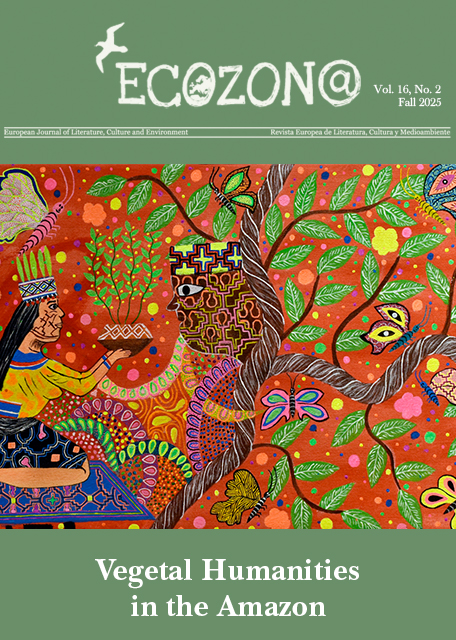<b>Madeleine de Scudéry’s Animal Sublime, or Of Chameleons</b> // Lo sublime animal de Madeleine de Scudéry, o De los camaleones
DOI:
https://doi.org/10.37536/ECOZONA.2016.7.1.977Keywords:
ecofeminism, chameleons, Madeleine de Scudéry, René Descartes, Claude Perrault // Ecofeminismo, camaleones, Claude PerraultAbstract
Drawing from Erica Harth’s work, animal studies, and ecofeminism, I explore the ways in which Scudéry engages in the important seventeenth-century debates over animal reason. Her engagement in these debates is significant: it foregrounds the fact that René Descartes’s conception of the animal-as-machine was immediately challenged by his contemporaries. In her “Story of Two Chameleons,” Scudéry challenges early modern moral and especially scientific representations of the chameleon, which limit our understanding of the chameleon to a figure for negative human qualities or to an object of scientific experimentation. Scudéry does so in ways that parallel her career-long vindication of women as elevated beings endowed with reason. Scudéry’s ethical stance towards the animal, attributing to it the capacity to reason and establishing a relation of friendship or amitié between the human and non-human animal, disrupts both negative metaphorical moral discourse, on the one hand; and the scientific domination and objectification of the animal exemplified by Claude Perrault’s Anatomical Description, on the other. Her “Story of Two Chameleons” suggests that these creatures are sublime, in the late seventeenth-century sense of “pure,” “refined,” and “elevated.” Through a process of sublimation that, for instance, transforms excrement into musk, an eyeball into a pearl, Scudéry metaphorically elevates the status of her chameleons. In effect, Scudéry suggests that, just like the human animal, the chameleon can (albeit problematically) dominate its “nature within.”
Resumen
Inspirándose en la obra de Erica Harth, en los estudios de los animales y en el ecofeminsmo, exploro las formas en que Scudéry se involucra en los debates importantes del siglo diecisiete sobre el razonamiento de los animales. Su implicación en estos debates es significativa: pone en primer plano el hecho de que la idea de René Descartes del animal-como-máquina fue inmediatamente cuestionada por sus contemporáneos. En su “Historia de dos camaleones”, Scudéry desafía la moral moderna y en especial las representaciones científicas del camaleón, que limitan nuestro entendimiento del camaleón a una figura para las cualidades humanas negativas, o a un objeto de experimentación científica. Scudéry hace esto de forma paralela a su defensa, a lo largo de su carrera, de las mujeres como seres elevados dotados de razonamiento. El posicionamiento ético de Scudéry hacia el animal, atribuyéndole la capacidad de razonar y estableciendo una relación de amistad o amitié entre el animal humano y el no-humano, perturba tanto el discurso moral metafórico negativo así como la dominación científica y la objetificación del animal ejemplificada por la Descripción anatómica de Claude Perrault. Su “Historia de dos camaleones” sugiere que estas criaturas son sublimes, en el sentido de “puro”, “refinado” y “elevado” de finales del siglo XVII. Por medio de un proceso de sublimación que, por ejemplo, transforma el excremento en almizcle, un globo ocular en una perla, Scudéry eleva metafóricamente el estatus de sus camaleones. En efecto, Scudéry sugiere que, como el animal humano, el camaleón puede (aunque problemáticamente) dominar su “naturaleza interior”.
Downloads
Downloads
Published
Issue
Section
License
Authors who publish with this journal agree to the following terms:
a) Authors retain copyright and grant the journal right of first publication with the work simultaneously licensed under a Creative Commons Attribution License that allows others to share the work with an acknowledgement of the work's authorship and initial publication in this journal (CC BY-NC for articles and CC BY-NC-ND for creative work, unless author requests otherwise.
b) Authors are able to enter into separate, additional contractual arrangements for the non-exclusive distribution of the journal's published version of the work (e.g., post it to an institutional repository or publish it in a book), with an acknowledgement of its initial publication in this journal.
c) Authors are permitted and encouraged to post their work online (e.g., in institutional repositories or on their website) prior to and during the submission process, as it can lead to productive exchanges, as well as earlier and greater citation of published work (See The Effect of Open Access).










